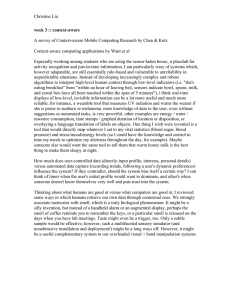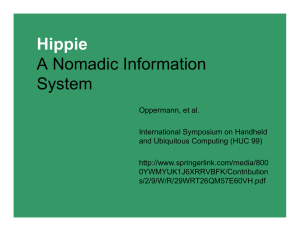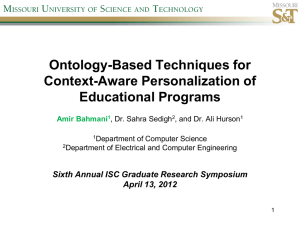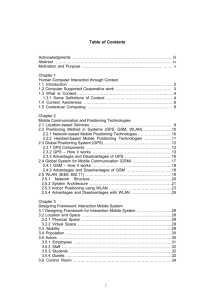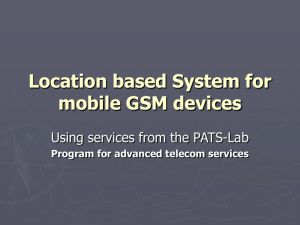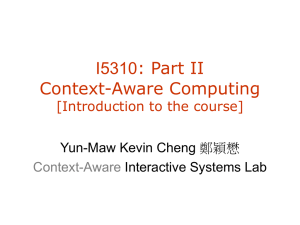AN INNOVATIVE MOBILE APPLICATION FOR CONSTRUCTION PROGRAMME MANAGERS
advertisement
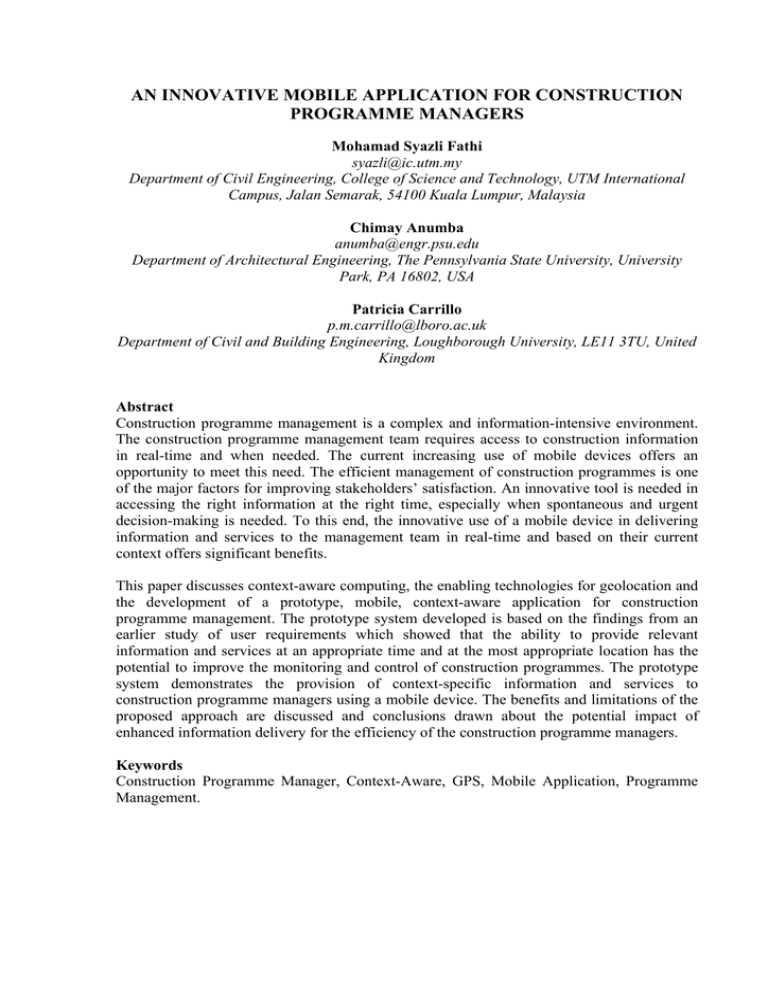
AN INNOVATIVE MOBILE APPLICATION FOR CONSTRUCTION PROGRAMME MANAGERS Mohamad Syazli Fathi syazli@ic.utm.my Department of Civil Engineering, College of Science and Technology, UTM International Campus, Jalan Semarak, 54100 Kuala Lumpur, Malaysia Chimay Anumba anumba@engr.psu.edu Department of Architectural Engineering, The Pennsylvania State University, University Park, PA 16802, USA Patricia Carrillo p.m.carrillo@lboro.ac.uk Department of Civil and Building Engineering, Loughborough University, LE11 3TU, United Kingdom Abstract Construction programme management is a complex and information-intensive environment. The construction programme management team requires access to construction information in real-time and when needed. The current increasing use of mobile devices offers an opportunity to meet this need. The efficient management of construction programmes is one of the major factors for improving stakeholders’ satisfaction. An innovative tool is needed in accessing the right information at the right time, especially when spontaneous and urgent decision-making is needed. To this end, the innovative use of a mobile device in delivering information and services to the management team in real-time and based on their current context offers significant benefits. This paper discusses context-aware computing, the enabling technologies for geolocation and the development of a prototype, mobile, context-aware application for construction programme management. The prototype system developed is based on the findings from an earlier study of user requirements which showed that the ability to provide relevant information and services at an appropriate time and at the most appropriate location has the potential to improve the monitoring and control of construction programmes. The prototype system demonstrates the provision of context-specific information and services to construction programme managers using a mobile device. The benefits and limitations of the proposed approach are discussed and conclusions drawn about the potential impact of enhanced information delivery for the efficiency of the construction programme managers. Keywords Construction Programme Manager, Context-Aware, GPS, Mobile Application, Programme Management. 1. INTRODUCTION The management of construction programmes was known to be experiencing unprecedented changes and challenges resulting from their complexity (Aritua et al., 2009) and informationintensive nature (Anumba et al., 2008) and, as such, information delivery is the key to better management, survival and success. Researchers have estimated that if this information could be managed effectively then savings of up to 25% in the construction cost could be achieved (Baldwin et al., 1999). Furthermore, construction activities are widely dispersed and site locations are frequently changed (Magdic et al., 2002) complicating the management of the projects. Modern project management methods and tools have evolved tremendously in order to overcome problems in construction management. The uses of these tools and methods have been widely known (Milosevic, 2003). However, with the growing complexity of single and multi-construction projects, the traditional methods of construction management need to be revised by using construction programme management. Construction programme management deals with the integration and management of multiple-construction projects involving complex resource utilisation with the intent of achieving benefits that would not be realised if they were managed separately. It has been suggested by researchers (Aziz et al., 2006) that by using wireless communication technologies, the information, communication and services delivery between project team members in the field and the office can be enhanced. Thus, rapid decisions can be made by the construction programme manager. However, researchers (May et al., 2005; Aziz et al., 2006) claimed that the existing mobile applications in the construction industry only support the communication of static information (such as project data, plans, drawings, etc.), and are unable to take into account the construction worker’s changing context and the dynamic project conditions. Similarly, most of the commercially available mobile applications for construction management are designed primarily to deliver pre-programmed project management tools without any consideration of the construction programme manager’s context. This often leads to irrelevant and inadequate information being supplied to the construction programme manager. Context-aware computing is an intelligent system that uses environmental context (user's location, time, identity, and activity) to inform the computing device of its current context (Burrell and Gay, 2001). Context-aware computing applications examine and react to a user’s changing context in order to help promote and mediate people’s interactions with each other and their environment (Schilit et al., 2002). In addition, some applications have the ability to provide highly-specific data and services by intelligent interpretation of their context (Aziz et al., 2006). It is suggested that awareness of a user’s context (such as user role, task, preferences, location, site conditions, etc.) in mobile construction applications will enhance the effectiveness of construction programme delivery by providing information and services relevant to a particular context. Firstly, this paper reviews construction programme management. Secondly, it discusses context-aware computing in terms of the enabling technologies for location-tracking and data transfer. It goes on to present and discuss the development of a prototype mobile information system for construction programme management which includes the system architecture and the features of the prototype application. Finally, a number of conclusions are drawn. 2. CONSTRUCTION PROGRAMME MANAGEMENT A construction programme requires an expanded scope of construction management services, which is commonly referred to as construction programme management. Construction programme management services normally focus on managing the planning, design and construction of a building programme involving multiple projects and multiple phases on either single or multiple sites. The Construction Programme Manager (CPM) is responsible for the overall projects (within the programme), including awarding contracts, procuring materials, monitoring performance (including costs and schedules) and managing the necessary reporting and communications. Construction project and programme management have been used to build some of the greatest engineering achievements, from the Burj Khalifa tower in Dubai to complex structures such as the Beijing Olympic Stadium. In part, this success can be attributed to the construction project managers’ focus and the discipline inherent in project management, and the integration and coordination of such complex initiatives facilitated by the construction programme manager in a programme management framework, as suggested by the Project Management Institute (2008). Programme management provides a bridge between projects and the organisation’s strategy, they must be both adaptable and forceful, absorbing shocks and discontinuities yet ensuring that progress is achieved (Pellegrinelli, 2002). The construction programme manager needs to act like a strategic manager, using a wide range of skills and competencies to realise lasting organisational changes in the face of vested interests and cultural diversity. From a strategic management perspective, an organisation requires flexibility to shape and respond to its own environment. The fact is that today’s construction programme manager must execute a programme effectively with two drivers that are in a constant state of change: (1) people and (2) technology. • People (for a variety of reasons), come and go in today’s business or construction environment. Therefore, the organisation must have the ability to expand and contract on a rapid basis and react to changes in the marketplace. The ability to acquire people rapidly and to enable them to make a valuable contribution quickly is a necessity for survival in today’s marketplace (Brown, 2008). • Technology that changes rapidly. The programme manager must also deal with constant changes in technology and innovation. As technology changes, every company has opportunities to improve operations (Archibald, 2003). A core element of programme management is tracking the progress of projects and taking action (Pellegrinelli, 1997). Effective and efficient project deliverables are creating competitive advantages for an organisation (in monitoring and controlling the construction programme). Therefore, tools are needed to support construction programme managers in monitoring, controlling and making an informed decision in construction programme management. The rapid developments in mobile and wireless ICT and mobile devices have now enabled the new possibilities of portability and on-demand access to information systems and communication tools that construction organisations are requesting (Löfgren, 2007). However, the existing tools in construction programme management only support the delivery of static modes of information. They are pre-programmed and thus not able to take into account the construction programme managers’ context. This support can be provided through the innovative used of context-aware computing technology that has the capabilities to supply specific information in real-time and as needed, so that decision makers can make informed decisions based on the most important relevant facts. 3. CONTEXT-AWARE COMPUTING Context is a powerful and long-standing concept in human-computer interaction (HCI). Human-computer interaction is a discipline concerned with the design, evaluation and implementation of interactive computing systems for human use in a social context, and with the study of the major phenomena surrounding them (Ghaoui, 2006). Interaction with computation is by explicit acts of communication (e.g. pointing to a menu item) and the context is understood (e.g. default settings). Context can be used to interpret explicit acts, making communication much more efficient (Ghaoui, 2006). The use of context-aware computing technologies enables mobile applications to deliver context-specific information and services to the user. According to Aziz (2005), the use of context-aware information delivery is able to eliminate distractions for the users (related to the volume and level of information). Context-aware computing also enhances the use of mobile information systems in construction programme management by not just providing a filtering mechanism (to deliver information relevant to the task at hand) but also by increasing efficiency and integrity (being able to make an informed decision). Context-aware computing also has the potential to increase usability by decreasing the level of interaction required between a mobile device and the user (Aziz et al., 2005). One of the most important dimensions and commonly-used context attributes in contextaware computing is based on location. According to Smailagic et al. (2001), many frameworks have been developed utilising the location context. In published mobile computing research (Pagonis and Dixon, 2004; Pashtan, 2005), the location parameter is most often used to approximate the context and to implement context-aware applications. Mobile computing applications, characterised by devices that are operational and operated while on the move (e.g. PDA-phones, mobile phones), can significantly benefit from a context location. The following section presents, classifies and reviews the enabling technologies to determine the context location. It also compares the technologies for location-tracking and data transfer to determine their applicability to the research. 3.1 Geolocation Geolocation involves geographically localised information or, in other words, associating digital resources with a physical location. According to Bonsor (2001), a location-based service system will use a combination of Geographic Information Systems (GIS) with any location-tracking technology such as a Global Positioning System (GPS), Radio Frequency Identification (RFID) and/or a Wireless Local Area Network (WLAN). Geographic data is an important aspect of any location system. Geographic Information Systems (GIS) provide the tools to provide and administer base-map data such as manmade structures (streets, buildings) and terrain (mountains, rivers). GIS is used to manage point-of-interest data such as the location of petrol stations, restaurants, hotels, etc. GIS information also includes information about the radio frequency characteristics of the mobile network. This allows the system to determine the serving cell site of the user. A variety of different location tracking technologies can be found with significantly different characteristics, infrastructure and device requirements. Location-tracking technologies can be classified as micro (location-tracking in an indoor environment), macro (location-tracking in an outdoor environment) and hybrid (a combination of micro- and macro-location-tracking technologies). The competing location-tracking technologies are briefly reviewed in Table 1. Technology Table 1: Location-tracking Technologies Brief Description Wireless Local Area Network of devices that connect via radio frequency, such as 802.11b. These Network (WLAN) devices pass data over radio waves and provide users with a network with a range of 70 to 300 feet (21.3 to 91.4 meters). Global Positioning Global Positioning System (GPS) receives signals from multiple satellites and System (GPS) employs a triangulation process to determine physical locations with an (Oloufa et al., 2003) accuracy of approximately 0.5 - 5m (commercial use). Time Difference of The Time Difference of Arrival (TDOA) technique is one of the position Arrival (TDOA) location techniques for cellular-type wireless communication systems. TDOA (Aatique, 1997) techniques are based on estimating the difference in the arrival times of the signal from the source at multiple receivers. Active Badge An Active-Badge system uses infrared emissions from a small infrared badge Infrared (Want et carried by the object of interest. A centralised server receives the emitted al., 1992) signals and provides the location information. Radio Frequency RFID is a small and battery-less microchip that can be attached to consumer Identification goods, animals, equipment and other objects to track their movements. RFID (RFID) (Bahl and tags are passive and only transmit data if prompted by a reader. The reader Padmanabhan, transmits radio waves that activate the RFID tag. The tag then transmits 2000) information via a pre-determined radio frequency. This information is captured and transmitted to a central database. 3.2 Coverage Area and Data Transfer Table 2 shows the advantages and disadvantages of the technologies in terms of the coverage area and data transfer capabilities for use in developing an application. Table 2: Competing Technologies Global City-wide Campus-wide Indoor, room level No need for antennas/readers No need for line-ofsight (travelling in a straight line) High Data Transfer Capabilities WLAN GPS A-GPS Active RFID X X √ √ √ TDOA Infrared √ √ √ √ √ Passive RFID X X X √ X X X √ √ √ √ √ √ X √ X X √ √ √ X X X √ X √ √ √ X X X X √ X X X X X X The comparison of technologies in Table 2 also shows that GPS, A-GPS and WLAN technologies have better features and great potential for utilisation as technologies for mobile-application development. This is due to the coverage area and enabling features, such as there being no need for either an antenna or line-of-sight (where the signal is not required to travel in a straight line to function), which is important for mobile applications where users are moving back and forth from an indoor to an outdoor environment. Moreover, only WLAN is able to provide the high data transfer capabilities that are required to transfer huge amounts of programme management data. 4. PROTOTYPE DEVELOPMENT The concept of supplying specific information and services to the construction programme manager has become technically and financially feasible because of the capability of integrating mobile devices, context-awareness, data, voice and positioning technologies. Although on a small scale, research works by Aziz et al., (2006) proved that the concept was achievable. The prototyping process was chosen for the developers to design and build a scaled-down functional model of a desired system, which allows the developer to demonstrate the working model to the user. The prototype gives the users an ‘early feel’ of the system through showing what the application will do, how a user will interact with it and what it will look like. Furthermore, by using the prototyping approach, what the user wants from the system will be discovered exactly, as well as what it is feasible for the system to deliver. The prototype system developed was based on the findings from an earlier userrequirements study (Fathi et al., 2007) which showed that the ability to provide relevant information and services at an appropriate time and at the most appropriate location has the potential to improve the monitoring and control of construction programmes. 4.1 System Architecture of the Prototype Application Based on the literature (Abowd et al., 1997; Imielinski and Viswanathan, 1994), the design goal and user requirements identified in Fathi (2009) allowed the researchers to develop a system architecture for the design of a context-aware information and services tool for the construction programme manager, as shown in Figure 1. The context-aware information system (C-aIS) architecture consists basically of four main components: 1. The Positioning System – using GPS and WLAN to determine the current location; 2. The Mobile Client – a mobile device will receive location coordinates from GPS and WLAN, then transmit them to the application server. The mobile client will also receive information or data from the server; 3. The Context Information Network System – the wireless network environment for transmitting contextual information and data to the users; and 4. The Server System – the context-aware server engine will process the location data gathered from GPS and WLAN and intelligently choose the right information and services from the servers available in the system (Database server, the GIS server and the Enterprise Project Management server). LOCATION SYSTEM (GPS & WLAN) GPS Data Programme Management Server WLAN NETWORK PDA (GPS & WLAN Capability) n tio ca Lo s te na di or Co Data CAIS Server Engine Database Server INTERNET (Wireless) CAIS Client Engine Programme Manager GIS Database Server MOBILE CLIENT (Users & Tracked Objects) NETWORK SYSTEM (Wireless) SERVER SYSTEM (Database & Map) Figure 1: Context-Aware Information System (C-aIS) Architecture The context-aware application supplies information and services based on the construction programme manager’s current location by using the Global Positioning System (GPS) for the outdoor location coordinates and a Wireless Local Area Network (WLAN) for the indoor location coordinates. The location coordinates (latitude, longitude and altitude) are then transmitted from the mobile client (PDA-Phone with GPS and WLAN capabilities) to the CaIS application server through a wireless network. The C-aIS application server registers the query issued by the mobile client and then performs the following operations until the query is active: 1. Retrieve information associated with the current context together with its scope and load information to the user’s device (based on selected context information); and 2. Periodically monitor the current user’s context and check whether it belongs to the current information scope. If an out-of-scope condition is detected, the service manager restarts. The C-aIS application server will process the coordinates received based on the context defined (such as location, time, activity, task and project). This process will involve the programme management servers, database servers and GIS servers, so that it can be programmed to automatically send specific information and services to the construction programme manager (such as the project information required, issues to be resolved at the project site, advice, coordination or a full overview of the project) based on the current context. This flow of project information and services can be utilised by the construction programme manager to monitor a programme’s performance and progress, thus a multipleproject environment will be efficiently managed. 4.2 Features of the Prototype Application The prototype application has been developed to have several key features (Figure 2) such as a real-time, context-aware, project and programme dashboard, real-time information on the status of materials and issues on sites, context-aware services and context-aware searching capabilities. The context-aware project and programme dashboard was designed to display the operational status of all projects or the performance of a programme. The application helps manage project interdependencies, especially when construction programme managers are making multiple site visits. Information such as programme performance, project progress, contractual information, unfinished tasks and information relevant to the construction programme manager’s current context (location and activity) can be automatically updated on his/her mobile device. This may enhance the real-time visibility of the status of projects and programmes, and allow accurate judgement and effective reporting processes in construction programme management Figure 2: Features in the prototype application 5. ANALYSIS & DISCUSSION The construction programme manager will be provided with, or can get immediate access to, the central repository of project data that grows as information about the project or programme is developed by the team members. Various programme information such as feasibility studies, budgets, approvals, minutes, KPI, etc., can all be viewed or supplied through the mobile device. Thus, the construction programme manager can use up-to-date and relevant information to make an informed decision. It is important to note that the management of a construction programme (or multiple projects) presents challenges that are different from those of single-project management. The situations are complex (unpredictable and non-linear) (Aritua et al., 2009) and information requirements are huge (to cover the macro- and micro-levels) (Fathi et al., 2007). Thus, designing and developing mobile, context-aware, construction programme management applications is challenging and demanding. The technology itself is rather complex and involves several fields and technologies that contribute to the final outcome (such as integration, system architecture and interaction design). The concept delivers benefits to the organisation through a new way of managing projects and programmes, which in turn delivers to the construction programme management the benefits of high efficiency, good visibility and good governance. However, this research is still in the early stages. There are concerns about security, privacy and the reliability of the network, which will be the focus for future research. 6. CONCLUSIONS AND RECOMMENDATIONS This paper has given an overview of the context-aware computing and location-tracking technologies. The review also shows the potential of context-aware computing for construction programme managers. The findings show that to develop a mobile contextaware application, a system should be able to integrate multiple technologies such as contextaware computing, mobile devices, GPS, WLAN and an enterprise project management system. Based on the reviews and understanding of the construction programme manager’s role in construction programme management, a mobile context-aware application may be able to address the following: 1. Improvements in terms of a more timely decision-making; 2. Improvements in managerial tasks in terms of better project planning, scheduling, monitoring and control; 3. The provision of a tool or a system that enables construction programme managers to monitor, control and get access to a specific project information across all projects (for health checks, progress reporting, issues management and risk management) to ensure that the programme stays aligned with the overall strategic objectives of the organization; and 4. The ability to make an informed decision based on instant access to information. Technology itself would not guarantee success if the project management system fails to meet the needs of the user. Therefore, it is important to understand the relationship and interaction between the user (human) and the application (computer) before developing any computer application. The success of an application depends on the right research philosophy, methodology and techniques. This will also be the focus of future research. ACKNOWLEDGEMENT The authors would like to thank Universiti Teknologi Malaysia and the Ministry of Higher Education, Malaysia for sponsoring this research through grant number 77948. REFERENCES Aatique, M. (1997) Evaluation of TDOA Techniques for Position Location In CDMA Systems. Faculty of the Electrical Engineering. Blacksburg, Virginia, Virginia Polytechnic Institute and State University. Abowd, G. D., Atkeson, C. G., Hong, J., Long, S., Kooper, R. & Pinkerton, M. (1997) Cyberguide: A Mobile Context-Aware Tour Guide. ACM Wireless Networks, Vol. 3, pp. 421-433. Anumba, C. J., Pan, J., Issa, R. R. A. & Mutis, I. (2008) Collaborative Project Information Management In A Semantic Web Environment. Engineering, Construction and Architectural Management (ECAM), Vol. 15, pp. 78 - 94. Archibald, R. D. (2003) Managing High-Technology Programs and Projects, John Wiley and Sons. Aritua, B., Smith, N. J. & Bower, D. (2009) Construction Client Multi-Projects - A Complex Adaptive Systems Perspective. International Journal of Project Management, Vol. 27, pp. 72-79. Aziz, Z. (2005) Context-Aware Information Delivery for Mobile Construction Workers. Civil and Building Engineering. United Kingdom, Loughborough University. Aziz, Z., Anumba, C. & Law, K. (2006) Using Context-Awareness and Web-Services to Enhance Construction Collaboration. In Rivard, H., Melhem, H. & Miresco, E. (Eds.) Joint International Conference on Computing and Decision Making in Civil and Building Engineering. In Rivard H., Melhem H. & Edmond Miresco (Eds.), 14-16 June 2006a, Montreal, Canada, ASCE. Aziz, Z., Anumba, C. J., Ruikar, D., Carrillo, P. M. & Bouchlaghem, N. M. (2005) Context Aware Information Delivery for On-Site Construction Operations. 22nd CIB-W78 Conference on Information Technology in Construction. Technische Universitat Dresden, Germany, Institute for Construction Informatics. Bahl, P. & Padmanabhan, V. N. (2000) RADAR: An in-Building RF-Based User Location and Tracking System. In Proceedings of the IEEE Infocom 2000. Tel-Aviv, Israel. Baldwin, A. N., Thorpe, A. & Carter, C. (1999) The Use of Electronic Information Exchange on Construction Alliance Projects. Automation in Construction, Vol. 8, pp. 651-662. Bonsor, K. (2001) How Location Tracking Works. Atlanta, GA, HowStuffWorks.com. Brown, J. T. (2008) The Handbook of Program Management: How to Facilitate Project Success with Optimal Program Management New York, McGraw-Hill Professional Burrell, J. & Gay, G. K. (2001) Collectively Defining Context in a Mobile, Networked Computing Environment. CHI '01 Extended Abstracts on Human Factors in Computing Systems. Seattle, Washington, ACM Press. Fathi, M. S. (2009) Micro and Macro-Level Context-Aware Information Delivery for Construction Programme Managers. Civil and Building Engineering Department. Loughborough, Loughborough University. Fathi, M. S., Anumba, C. J., Carrillo, P. & Aziz, Z. (2007) Construction Programme Management - Current Context. In Garvin, M., Edum-Fotwe, F. & Chinowsky, P. (Eds.) Proceedings of the 2007 ASCE/CIB Construction Research Congress. Grand Bahama Island, Academic Event Planners. Ghaoui, C. (2006) Encyclopaedia of Human Computer Interaction, Covent Garden, London, Idea Group Reference. Imielinski, T. & Viswanathan, S. (1994) Adaptive Wireless Information Systems. Proceedings of Special Interest Group in Database Systems (SIGDBS). Tokyo, Japan. Löfgren, A. (2007) Mobility In-site: Implementing Mobile Computing in a Construction Enterprise. The Communications of the Association for Information Systems, Vol. 20, pp. 1-12. Magdic, A., Rebolj, D., Cuš-Babic, N. & Radosavljevic, M. (2002) Mobile Computing in Construction. In Agger, K. (Ed.) Proceedings of International Council for Research and Innovation in Building and Construction (CIB W78 Conference). In Agger K. (Ed.), 12 – 14 June 2002, Aarhus School of Architecture, Denmark. May, A., Mitchell, V., Bowden, S. & Thorpe, T. (2005) Opportunities and Challenges for Location Aware Computing in the Construction Industry. Mobile HCI 2005. Salzburg, Austria, ACM. Milosevic, D. Z. (2003) Project Management ToolBox: Tools and Techniques for the Practicing Project Manager New Jersey, John Wiley & Sons. Oloufa, A. A., Ikeda, M. & Oda, H. (2003) Situational Awareness of Construction Equipment Using GPS, Wireless and Web Technologies. Automation in Construction, Vol. 12, pp. 737-748. Pagonis, J. & Dixon, J. (2004) Location Awareness and Location Based Services - Part 1 Positioning and Terminology. Symbian Ltd. Pashtan, A. (2005) Mobile Web Services, Cambridge, Cambridge University Press. Pellegrinelli, S. (1997) Programme Management: Organising Project-Based Change. International Journal of Project Management, Vol. 15, pp. 141-149. Pellegrinelli, S. (2002) Shaping context: the role and challenge for programmes. International Journal of Project Management, Vol. 20, pp. 229-233. Project Management Institute (2008) The Standard for Programme Management, Newton Square, Project Management Institute Inc. Schilit, B. N., Hilbert, D. M. & Trevor, J. (2002) Context-Aware Communication. IEEE Wireless Communications, Vol. 9, pp. 46-54. Smailagic, A., Siewiorek, D. P., Anhalt, J., Kogan, D. & Wang, Y. (2001) Location Sensing and Privacy In a Context-Aware Computing Environment IEEE Wireless Communications Vol. 9, pp. 10-17. Want, R., Hopper, A., Falcão, V. & Gibbons, J. (1992) The Active Badge Location System. ACM Transactions on Information Systems, Vol. 10, pp. 91-102.
